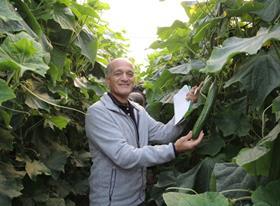
Vegetable seed company Hazera, which has for some years sought improvements in cucumber genetics – particularly in the mini cucumber category – has revealed that it is now seeking further marketing opportunities for the wider cucumber business.
Hazera’s global cucurbits product manager Mark van der Zouwen confirmed that the company is working on a number of different areas in the cucumber category.
“Hazera’s heritage started in mini cucumbers, those that are mostly grown in non-heated greenhouses in the Mediterranean region, in the Middle East, Central Asia and in the Americas as well,' he explained. 'Today mini cucumbers are also grown in heated greenhouses in North America and northern Europe.
'Hazera now covers the complete range,' van der Zouwn continued. 'We have introduced many breakthrough innovations since the 1980s – for example, strong improvements in fruit quality (uniform shape and colour), drastic yield improvement, adaptability to different growing conditions and, more recently, long shelf life.
'In the early 1980s we also started specialising in long types for non-heated greenhouses, mostly in the Mediterranean region. Here we introduced similar innovations, including extended shelf-life – many remember the Suprami variety – and lately we have come up with varieties combining resistances to both powdery mildew and viral diseases such as CVYV and CYSDV.'
In the mini cucumber category, Hazera is now in the top three breeding companies worldwide, with varieties that are well suited to the Mediterranean, Middle Eastern and Central American markets.
“Our market share in mini cucumbers is growing steadily, and we have extended our breeding activities, locating them in the very middle of these regions,' said van der Zouwn. 'Beside successful varieties for spring-summer like the Bereket and Dennis, we now launching new varieties for the more stressful cool season, as successors to Cohiba.
'Another very interesting development is the midi cucumber for heated greenhouses, like our spring-autumn variety Nikifor that offers high yield and fruit quality, for example in Poland where high-tech growers are using it.”
Hazera’s breeding has also led to strong production line in baby cucumbers, featuring fruits of 8-12 cm, which have rapidly gained popularity in many markets where healthy snacking and convenience are booming.
However, longer types are very much in focus again, boosted by new breeding activities in Spain. Here, Hazera recently launched the Batallón variety in Almeria and the Granada region.
“This is a winter variety with excellent colour, length and shelf life and resistance to viruses,' van der Zouwn explained. 'The developments in long cucumber breeding in Spain will certainly have a positive consolidation in other regions with similar growing conditions, such as Greece, Mexico, Oceania and South Africa.”
One of the most recent areas of focus is the Chinese market, for which Hazera has recently started breeding activities.
“With our vast experience as a solid base, our ambition is to incorporate the needs and types for the Chinese market in our programmes,' he continued. 'If we want to be a global specialist, we must be present in this growing market that is the biggest worldwide and very open to innovations. Chinese cultivation and consumption are quite different from other regions. So we must be very aware to respect the needs and traditions of the Chinese while bringing innovation at the same time.”
Looking ahead to the future of the category for Hazera, van der Zouwn noted that the group will further extend its breeding activities to all important regions for this worldwide crop.
'Our rich gene pool will be used to create genetic diversity fine-tuned to the major production areas,' he said. 'Disease resistances, especially to root and viral diseases will be crucial, and could be a way to avoid costly grafting. We’ll adapt our varieties to effective high-yield growing techniques. And last but not least we will develop products responding to the needs of the entire fresh produce chain.
'The aim is to look for possible innovations to turn bulk products into products that offer better convenience and superior added value to consumers. After all they are the ones who consume the final product and for whom we are working every day.”






No comments yet